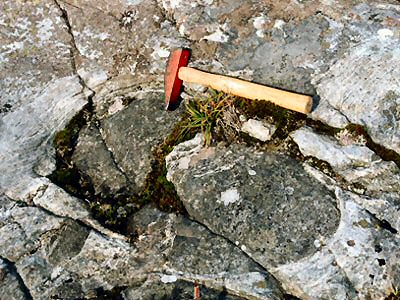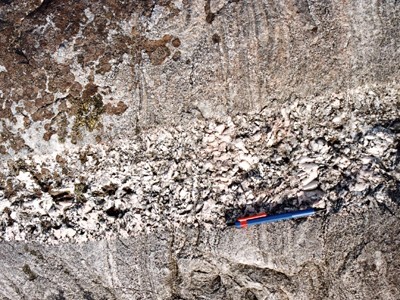Earth Science Conservation Review
| Croagh Mountain - PreCambrian | Fermanagh |
| Site Type: | Crag, Crags, Inland exposure |
| Site Status: | ASSI |
| Grid Reference: | G985630 |
| Google maps: | 54.51585,-8.02314 |
| Rocks | |
|---|---|
| Rock Age: | Precambrian (Moinian) |
| Rock Name: | Lough Derg Group, Slishwood Division |
| Rock Type: | Metabasite, Pegmatite, Psammite |
| Interest | |
Summary of site:
The Lough Derg Inlier contains the oldest rocks seen in Northern Ireland. They form the basement of the region, the foundation underpinning all later rock formations. An inlier is an area of rock completely surrounded by younger rocks, a window through the ‘shallow' sub-surface rocks that reveals deeper and older formations. The rocks seen here are the Lough Derg Group, Slishwood Division, belonging to the last major division of the Precambrian, called the Proterozoic.
Most of the Lough Derg Inlier is in the Irish Republic but an area about 10km long by 5km deep extends into Northern Ireland immediately north of the western end of Lower Lough Erne. The rocks are best seen near the summit of Croagh Mountain and on its southern and western slopes. They are mostly gneisses, i.e. rocks that have undergone high grade regional metamorphism (meaning that they reached very high temperatures under high pressures, almost approaching the molten state). This gives the rocks a banded appearance, often breaking into lens-like structures with layers of differing composition. This gneiss is quartz rich (psammite) but also contains the minerals plagioclase (a feldspar) with muscovite and biotite (micas). There are also some thin horizons of mica schist. The rocks have a tendency to weather into flags.
The outcrop also shows well developed metabasites (highly altered basic intrusions with the composition of basalt) in the gneiss. The high level of deformation has broken them into pods and boudins (sausage shaped masses) up to a metre across.
The original rocks before this intense metamorphism were almost certainly pure sandstones with rare and thin shale or mudstone horizons. They were later intruded by molten basic (dolerite) dykes (the metabasites). Opinions on the presence of sedimentary structures have changed since the full account was written and it is now believed that traces of original bedding planes can be seen, with suggestions of cross-bedding in places.
The grade or intensity of metamorphism is reflected in the mineralogy of the rock as characteristic suites of new minerals become stable with changing temperatures and pressures. There is clear evidence in the Lough Derg Group of two entirely separate episodes of metamorphism. The first was intense, creating granulite facies showing a granoblastic texture (when rock is recrystallized into a mass of equal grain sizes). But also within the rock are clear indications of a second episode, less intense than the first but of medium to high grade, producing amphibolite facies. It has ‘overprinted' the granulites of the earlier episode but without entirely obliterating them. It might be expected that rocks of considerable age, such as these, would be metamorphosed more than once in their history but it complicates their interpretation, particularly determination of their age.
These rocks have been radiometrically dated using the presence of the rubidium 87 isotope. This isotope decays to strontium 87 at a constant rate from the moment of its creation and by measuring the proportion of both in the rock (a complex procedure), the date of creation of the rubidium mineral can be calculated. In this case a date of almost 900 million years emerges with a margin of error of 60 million years either way. This would make the first metamorphism a late Grenvillian event by comparison with the type Grenvillian rocks in west Co. Mayo. The original sediments, before metamorphism, were therefore older - possibly over a thousand million years - suggesting that they belong to the Moinian, a stage in the Upper Proterozoic (the last phase of the Precambrian). The second phase probably took place in the Caledonian orogeny, accompanied by large scale regional folding.
Veins of unaltered pegmatite (coarsely crystalline rock produced in the final stages of cooling from the molten state) are found throughout the Lough Derg Group, cutting through all the earlier rocks and their structures. They contain quartz, microcline feldspar and the micas biotite and muscovite. It was the microcline feldspar that provided the original raw material for the porcelain produced at the Belleek Pottery but the volume was insufficient to sustain volume manufacture and eventually suitable clays had to be imported.
This site offers the rare opportunity to examine and study Northern Ireland's oldest rocks, bestowing a national significance and status justifying Area of Special Scientific Interest designation. As the best site of this age, it could also become the type locality for the Lough Derg Group.
Most of the Lough Derg Inlier is in the Irish Republic but an area about 10km long by 5km deep extends into Northern Ireland immediately north of the western end of Lower Lough Erne. The rocks are best seen near the summit of Croagh Mountain and on its southern and western slopes. They are mostly gneisses, i.e. rocks that have undergone high grade regional metamorphism (meaning that they reached very high temperatures under high pressures, almost approaching the molten state). This gives the rocks a banded appearance, often breaking into lens-like structures with layers of differing composition. This gneiss is quartz rich (psammite) but also contains the minerals plagioclase (a feldspar) with muscovite and biotite (micas). There are also some thin horizons of mica schist. The rocks have a tendency to weather into flags.
The outcrop also shows well developed metabasites (highly altered basic intrusions with the composition of basalt) in the gneiss. The high level of deformation has broken them into pods and boudins (sausage shaped masses) up to a metre across.
The original rocks before this intense metamorphism were almost certainly pure sandstones with rare and thin shale or mudstone horizons. They were later intruded by molten basic (dolerite) dykes (the metabasites). Opinions on the presence of sedimentary structures have changed since the full account was written and it is now believed that traces of original bedding planes can be seen, with suggestions of cross-bedding in places.
The grade or intensity of metamorphism is reflected in the mineralogy of the rock as characteristic suites of new minerals become stable with changing temperatures and pressures. There is clear evidence in the Lough Derg Group of two entirely separate episodes of metamorphism. The first was intense, creating granulite facies showing a granoblastic texture (when rock is recrystallized into a mass of equal grain sizes). But also within the rock are clear indications of a second episode, less intense than the first but of medium to high grade, producing amphibolite facies. It has ‘overprinted' the granulites of the earlier episode but without entirely obliterating them. It might be expected that rocks of considerable age, such as these, would be metamorphosed more than once in their history but it complicates their interpretation, particularly determination of their age.
These rocks have been radiometrically dated using the presence of the rubidium 87 isotope. This isotope decays to strontium 87 at a constant rate from the moment of its creation and by measuring the proportion of both in the rock (a complex procedure), the date of creation of the rubidium mineral can be calculated. In this case a date of almost 900 million years emerges with a margin of error of 60 million years either way. This would make the first metamorphism a late Grenvillian event by comparison with the type Grenvillian rocks in west Co. Mayo. The original sediments, before metamorphism, were therefore older - possibly over a thousand million years - suggesting that they belong to the Moinian, a stage in the Upper Proterozoic (the last phase of the Precambrian). The second phase probably took place in the Caledonian orogeny, accompanied by large scale regional folding.
Veins of unaltered pegmatite (coarsely crystalline rock produced in the final stages of cooling from the molten state) are found throughout the Lough Derg Group, cutting through all the earlier rocks and their structures. They contain quartz, microcline feldspar and the micas biotite and muscovite. It was the microcline feldspar that provided the original raw material for the porcelain produced at the Belleek Pottery but the volume was insufficient to sustain volume manufacture and eventually suitable clays had to be imported.
This site offers the rare opportunity to examine and study Northern Ireland's oldest rocks, bestowing a national significance and status justifying Area of Special Scientific Interest designation. As the best site of this age, it could also become the type locality for the Lough Derg Group.
| Enlander, I., Dempster, M. & Doughty, P., 2025. Croagh Mountain - PreCambrian, County Fermanagh, site summary. [In] Earth Science Conservation Review. https://www.habitas.org.uk/escr/summary.php?item=125. Accessed on 2025-04-03 |
| Previous Site | Next Site |



